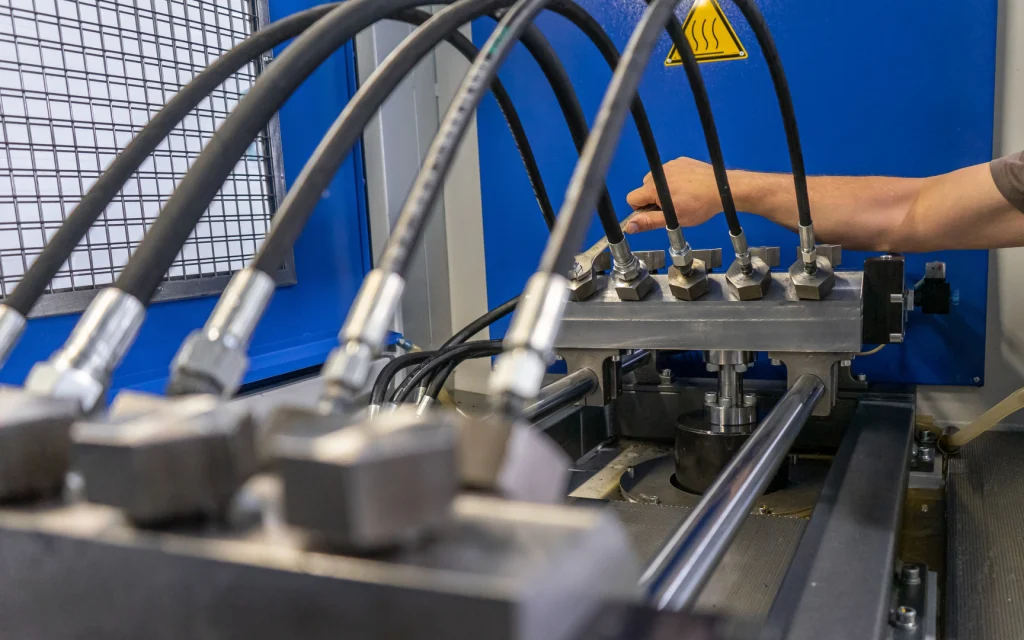Introduction
In precision casting and foundry operations, ensuring cast components meet stringent performance and safety standards is critical. Hydraulic or hydrostatic pressure testing plays a vital role in verifying the integrity of cast parts, detecting leaks, porosity, cracks or weak joints before the component goes into service.
What is Hydraulic Pressure Testing?
Hydraulic pressure testing (also called hydrostatic testing) involves filling a cast component or assembly with liquid (commonly water) and applying internal pressure for a specified time. The purpose is to check whether the part can hold pressure without leaking, deforming or failing. For cast components, this process confirms the casting and subsequent processing (machining, welding, joining) produce a defect-free end part.
Why It Matters for Cast Components
Cast parts may harbour internal shrinkage, porosity or cracks due to the casting process; pressure testing exposes these weak spots. Components used in hydraulic, pneumatic or fluid-handling systems must be leak-tight and capable of withstanding internal pressures under service conditions.
Quality assurance: A successful pressure test gives confidence in reliability, reduces risk of field failure and supports certification/compliance for critical applications.
Common Methods & Parameters
Hydrostatic Test: A liquid is used as the test medium; the part is filled, sealed and pressurized, then monitored for leaks or pressure drop.
Pneumatic or Gas Test: Uses air, nitrogen or another gas; more sensitive to leaks but higher risk if failure occurs. Fictiv+1
Key parameters include: test medium (water, oil, gas), test pressure (often a multiple of design or operating pressure), test duration, observational criteria (leakage, pressure decay, deformation).
Special concerns for cast components:Porosity may mask leaks or cause false passes, especially under gas testing. Machining after casting may expose subsurface voids making pressure testing even more important.

Implementation in a Casting Company
For a precision casting company offering hydraulic-type applications (valves, pump housings, fluid passages), the process may look like:
-
Design & cast the component using specified alloy and moulding method.
-
Perform cleaning, machining and finishing as required, ensuring internal cavities and surfaces are prepared.
-
Seal or cap all openings, fill with test fluid, purge air (especially in hydro tests) to ensure full fill.
-
Apply specified pressure for defined time. Monitor for pressure drop, visible leaks, deformation or failure.
-
Document the test result, including pressures, durations, temperatures and acceptance criteria.
-
Only accepted parts proceed to final finishing, assembly or shipment.
Benefits of Proper Pressure Testing
-
Reduces field failures, warranty claims and reputational risk.
-
Ensures castings meet functional requirements for high-pressure systems.
-
Allows the casting company to guarantee “pressure-tight” or leak-free castings, a strong market differentiator (especially for hydraulic-, marine- or fluid-system components).
-
Provides traceable quality data for customers in regulated industries (oil & gas, aerospace, marine).
Best Practices & Considerations
-
Use the correct test medium: hydro vs pneumatic depending on part.
-
Ensure parts are fully cleaned and dry (especially before gas tests) to avoid false readings.
-
Purge all air from the system before hydro test; air pockets can lead to misleading results.
-
Use fixtures and seals suited for cast components, rough cast surfaces may need special sealing arrangements.
-
Conduct tests at the correct temperature or include temperature-correction if necessary, ambient or part temperature can affect results.
-
Record all test conditions, expected versus actual pressure, duration, leak rate or pressure drop.
-
For castings with thin walls or complex geometry, simulation (e.g., casting flow/solidification analysis) and NDT (radiography, dye-penetrant) may complement pressure testing. lesueurinc.com
Conclusion
For any precision casting company aiming to supply high-integrity cast components for fluid-handling, hydraulic, marine or industrial systems, hydraulic pressure testing of castings is indispensable. By incorporating rigorous testing procedures, documenting results, and addressing casting/processing defects proactively, such companies build reliability, reduce risk and deliver value to customers requiring leak-free, high-pressure parts.